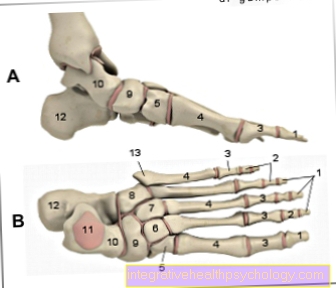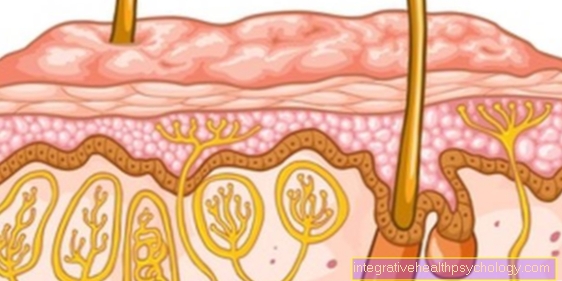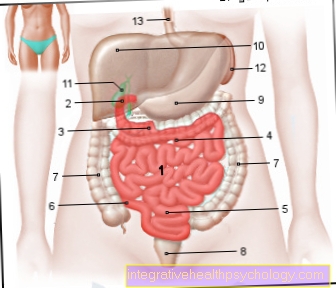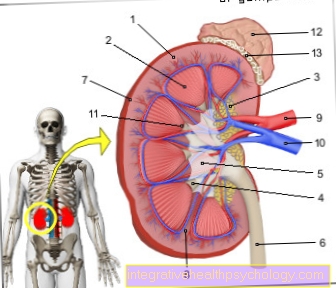HLA - Human Leukocyte Antigen
Definition - What is the HLA?
In medicine, the abbreviation HLA stands for the term human leukocyte antigen. The HLA are a group of molecules that consist of a protein part and a carbohydrate part. That is why they are called glycoprotein.
The HLA are located on the cell surface of each individual body cell and also on the surfaces of other organisms and pathogens.
The genes that code for the synthesis of HLA are very variable. Therefore, the HLA also show a high degree of variability from person to person. This enables the immune system to differentiate between the body's own cells and cells foreign to the body.
Thus, the success of organ transplants is related to HLA.
The HLA have several groups with various subgroups that can be found in different cell types in the body. The occurrence of some HLAs is associated with an increased probability of illness.
Which factors are also important in organ transplantation? You can find out this and much more at: Organ transplants - what to look out for

Indications for HLA determination
The HLA can be determined for several reasons. The transplantation of organs is very often an indication. The success of a transplant depends largely on how similar the antigens of the organ donor and recipient are. The higher the agreement in the structure of the glycoprotein, the higher the likelihood that the transplant will be successful in the course of the process. To prevent valuable organ donations from being wasted, the HLA is always determined.
The donation of stem cells is a special form of organ donation. However, the compatibility of the antigens is essential for success. This is why a rough determination is made when typing the donors. If a donor is shortlisted, the HLA is determined in detail.
HLA also play an important role in the development of certain diseases. This concerns the group of autoimmune diseases, which often arise from the body's own processes. For example, rheumatic diseases often occur when HLA-B 27 is present.
So-called celiac disease, which is associated with an intolerance to gluten, can also be influenced in its development by the HLA.
Some drug intolerances are also caused by some HLA.
You can read about the diseases listed in detail on the following pages:
- rheumatism
- Celiac disease - that's behind it
- Stem cell donation - what should you watch out for?
Procedure for the HLA determination
The HLA can be determined in four different ways. In either case, tissue is required from both the donor and recipient.
The exact determination of the structure of the HLA takes place with the so-called antigen determination. The polymerase chain reaction (PCR) process is used for this. Cells are destroyed and the exact sequence of bases of the DNA, which is released by the destruction, is reproduced and multiplied with the help of an enzyme.
One can also test whether the immune system of the recipient of a donation has ever had to react to exogenous HLA. To do this, the donor's immune cells are added to the recipient's blood. If there was no reaction, there was still no contact. This test is called antibody detection.
Finally, the tolerance of an organ donation can be assessed using the so-called crossmatch test. The test is similar to the detection of antibodies.
Recently, so-called flow cytometry has also been able to provide machine results.
In order to be able to understand the detection of antibodies, it is advisable to first find out about antibodies and their meaning. We offer you the following articles for this purpose: What are antibodies
HLA subgroups
HLA-B27
The HLA-B27 antigen belongs to the second group of HLA. It occurs on almost all cells in the human body and also plays an important role in regulating the immune system. Despite its role, it does not occur in the entire population.
This antigen is of medical relevance if it is present and has mutations. When a mutation is present, autoimmune diseases of the rheumatic type occur more frequently. For this reason, determining the status of HLA-B27 is an important criterion in the diagnosis and differential diagnosis of certain diseases.
However, the detection of the antigen is not a direct proof of a disease, as the person concerned does not necessarily have to be sick.
The diseases that are particularly common with a positive HLA-B27 status include Bechterew's disease, Reiter's disease, rheumatoid arthritis and inflammation of the eye.
In addition, if HLA-B27 is present, there is a certain protection against the outbreak of AIDS. The reasons for the connections are not known.
Additional information on the above-mentioned clinical pictures can be found at:
- ankylosing spondylitis
- Rheumatoid arthritis
- Reiter syndrome
- Inflammation of the eye - how dangerous is it?
HLA-DR
The HLA-DR antigen also plays an important role in the functioning of the immune system. One of the main tasks is to recognize substances that are foreign to the body, for example from pathogens such as bacteria. For this purpose, these substances are bound to the surface of the cells by the HLA-DR. Upon contact with immune cells, these are activated.
In addition, the HLA-DR plays an essential role in the success of an organ transplant in the first six months after the transplant. For this reason, the structure of the antigen of the organ donor and recipient must be as similar as possible. At the same time, the gene that codes for HLA-DR shows a very high degree of variability. As a result, the HLA-DR also has a high degree of variability, which makes it difficult to find the same donor and recipient antigens.
Furthermore, as in HLA-B27, the occurrence of the antigen is associated with the occurrence of some diseases. However, the detection of the antigen is not synonymous with the onset of the disease. These diseases include anemia, rheumatoid arthritis, some forms of diabetes, some kidney diseases, an underactive thyroid and many more.
HLA-DQ2
HLA-DQ2 is an antigen inherited from parents and found on the surface of most cells in the body. Among other features, HLA-DQ2 plays an important role in the development of celiac disease, an autoimmune disease of the intestine with gluten intolerance. A mutation in the affected gene is decisive for the development of the disease.
It is found in up to 30% of the population in Central Europe. An occurrence of the antigen is not to be equated with the actual illness, since not all people with the characteristic develop celiac disease. However, the risk of developing celiac disease is increased if one or both parents have it. Then the inheritance risk is up to 15%.
Due to the high occurrence of HLA-DQ2 in healthy people, the detection of the antigen cannot be used to diagnose celiac disease. Thus it has a low positive predictive value. In contrast, the negative predictive value is very high. This means that a person who cannot detect the antigen is very likely not to have celiac disease. Therefore, the evidence of HLA-DQ2 can only be used to rule out the disease.
At this point it is important to also take a look at the main page on celiac disease: What is Celiac Disease?
HLA-B51
HLA-B51 is also a surface molecule that is found on most cells in the human body. It is responsible for up to 20% for the occurrence of an autoimmune disease that is classified as rheumatic. This is called Behçet's disease and has a hereditary component.
While the disease is very rare in Central Europe, it is much more common in Turkey and Japan. The antigen HLA-B51 can be detected in up to 75% of patients.
At the same time, however, the evidence is not definitive for the disease. This means that healthy people can also have it and not develop Behçet's disease for their entire life.
Typically, the disease occurs suddenly with no apparent cause. In contrast to other autoimmune diseases, the diagnosis is not made on the basis of evidence of the antigen in the laboratory, but on the basis of the clinical appearance.
Read more about Behçet's disease at: Behcet's disease
Evaluation of the HLA values
When evaluating an HLA determination, a number of special features are checked. The common occurrence of some HLAs also plays a role. However, this process is very complex and is carried out by specially trained employees.
The evaluation takes place within a few days. With flow cytometry, a result can be available within minutes that is almost certainly correct.
HLA determination costs
Typing costs around € 50. If the typing is to be done in great detail, the costs can be increased. Thanks to the machine evaluation, the effort and thus also the costs have been reduced significantly in recent years.
Recommendation from the editor
The following articles also play an important role in the context of the human leukocyte antigen:
- Autoimmune Diseases - What is it?
- Everything you need to know about stem cell transplantation
- Rheumatism and the sub-forms
- How do you recognize rheumatism?
- Vasculitis - When blood vessels become inflamed





























